ACL Recovery: Assessing Knee Strength with Isokinetic Dynamometer
VerifiedAdded on 2023/06/09
|8
|3154
|486
Report
AI Summary
This report provides a detailed overview of the application of isokinetic dynamometers in assessing the strength of knee flexors and extensors following an anterior cruciate ligament (ACL) injury. It begins by introducing dynamometers and their use in measuring torque, force, and power, particularly in sports and physical therapy. The report elaborates on the isokinetic dynamometer's ability to accommodate various muscle movements and prevent injury by moderating forces. It discusses the historical perspective of isokinetic movements, highlighting their unique ability to allow maximum muscle contraction throughout the range of motion. The critical review section analyzes several studies that demonstrate the reliability and validity of isokinetic dynamometers in assessing muscle strength, evaluating the impact of ACL reconstruction on thigh circumference, and comparing isokinetic dynamometry with other measurement methods. The report also addresses the inter-machine reliability of different dynamometer models and the weakness in knee, hip, and ankle muscles following ACL injury. Ultimately, the report concludes that isokinetic dynamometers are valuable tools for assessing muscle function, optimizing training, and preventing injuries in sports and rehabilitation settings.

Running head: ISOKINETIC DYNAMOMETER
Isokinetic dynamometer to assess the strength of the knee flexors and extensors after
anterior cruciate ligament injury
Name of the Student
Name of the University
Author Note
Isokinetic dynamometer to assess the strength of the knee flexors and extensors after
anterior cruciate ligament injury
Name of the Student
Name of the University
Author Note
Paraphrase This Document
Need a fresh take? Get an instant paraphrase of this document with our AI Paraphraser
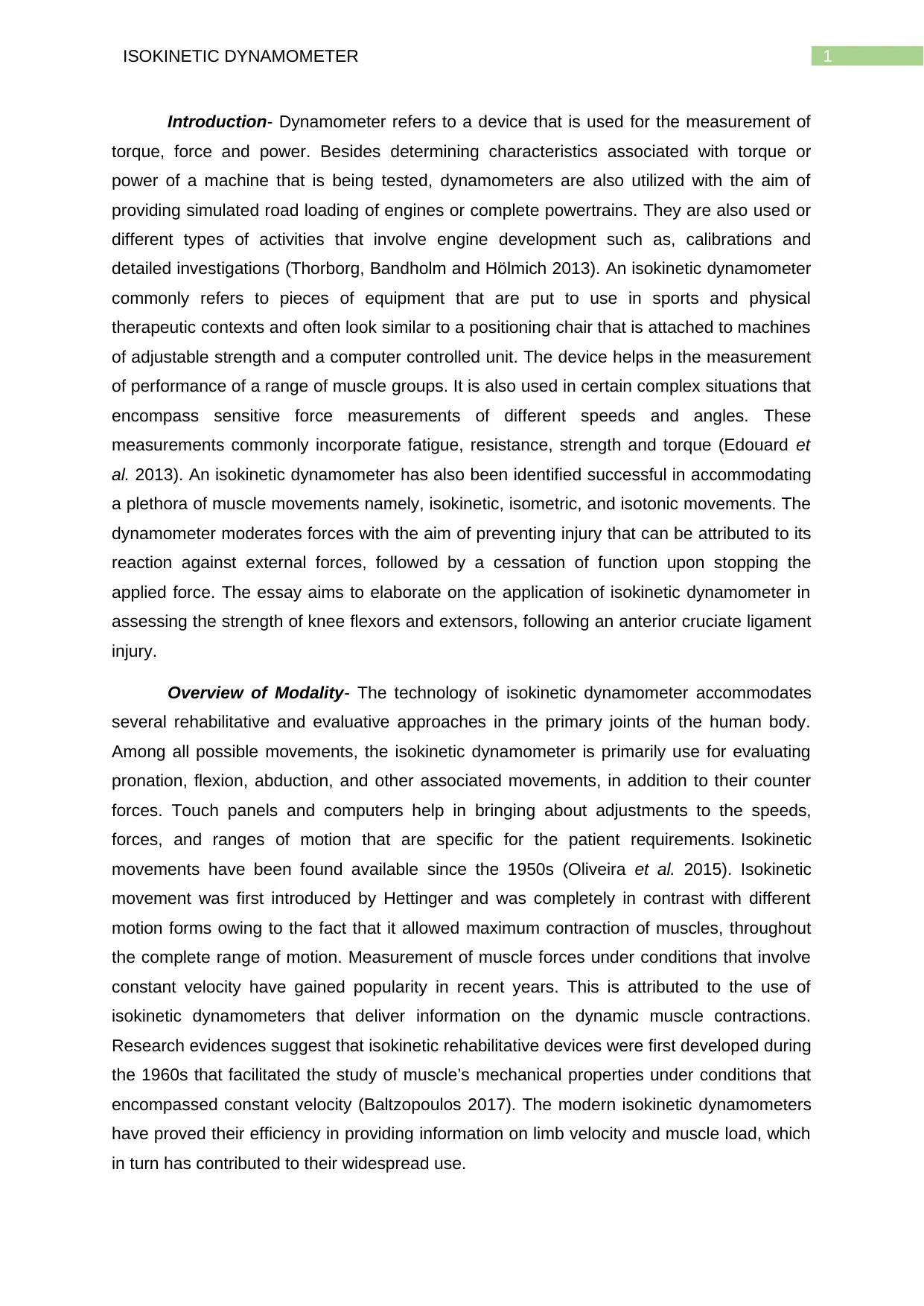
1ISOKINETIC DYNAMOMETER
Introduction- Dynamometer refers to a device that is used for the measurement of
torque, force and power. Besides determining characteristics associated with torque or
power of a machine that is being tested, dynamometers are also utilized with the aim of
providing simulated road loading of engines or complete powertrains. They are also used or
different types of activities that involve engine development such as, calibrations and
detailed investigations (Thorborg, Bandholm and Hölmich 2013). An isokinetic dynamometer
commonly refers to pieces of equipment that are put to use in sports and physical
therapeutic contexts and often look similar to a positioning chair that is attached to machines
of adjustable strength and a computer controlled unit. The device helps in the measurement
of performance of a range of muscle groups. It is also used in certain complex situations that
encompass sensitive force measurements of different speeds and angles. These
measurements commonly incorporate fatigue, resistance, strength and torque (Edouard et
al. 2013). An isokinetic dynamometer has also been identified successful in accommodating
a plethora of muscle movements namely, isokinetic, isometric, and isotonic movements. The
dynamometer moderates forces with the aim of preventing injury that can be attributed to its
reaction against external forces, followed by a cessation of function upon stopping the
applied force. The essay aims to elaborate on the application of isokinetic dynamometer in
assessing the strength of knee flexors and extensors, following an anterior cruciate ligament
injury.
Overview of Modality- The technology of isokinetic dynamometer accommodates
several rehabilitative and evaluative approaches in the primary joints of the human body.
Among all possible movements, the isokinetic dynamometer is primarily use for evaluating
pronation, flexion, abduction, and other associated movements, in addition to their counter
forces. Touch panels and computers help in bringing about adjustments to the speeds,
forces, and ranges of motion that are specific for the patient requirements. Isokinetic
movements have been found available since the 1950s (Oliveira et al. 2015). Isokinetic
movement was first introduced by Hettinger and was completely in contrast with different
motion forms owing to the fact that it allowed maximum contraction of muscles, throughout
the complete range of motion. Measurement of muscle forces under conditions that involve
constant velocity have gained popularity in recent years. This is attributed to the use of
isokinetic dynamometers that deliver information on the dynamic muscle contractions.
Research evidences suggest that isokinetic rehabilitative devices were first developed during
the 1960s that facilitated the study of muscle’s mechanical properties under conditions that
encompassed constant velocity (Baltzopoulos 2017). The modern isokinetic dynamometers
have proved their efficiency in providing information on limb velocity and muscle load, which
in turn has contributed to their widespread use.
Introduction- Dynamometer refers to a device that is used for the measurement of
torque, force and power. Besides determining characteristics associated with torque or
power of a machine that is being tested, dynamometers are also utilized with the aim of
providing simulated road loading of engines or complete powertrains. They are also used or
different types of activities that involve engine development such as, calibrations and
detailed investigations (Thorborg, Bandholm and Hölmich 2013). An isokinetic dynamometer
commonly refers to pieces of equipment that are put to use in sports and physical
therapeutic contexts and often look similar to a positioning chair that is attached to machines
of adjustable strength and a computer controlled unit. The device helps in the measurement
of performance of a range of muscle groups. It is also used in certain complex situations that
encompass sensitive force measurements of different speeds and angles. These
measurements commonly incorporate fatigue, resistance, strength and torque (Edouard et
al. 2013). An isokinetic dynamometer has also been identified successful in accommodating
a plethora of muscle movements namely, isokinetic, isometric, and isotonic movements. The
dynamometer moderates forces with the aim of preventing injury that can be attributed to its
reaction against external forces, followed by a cessation of function upon stopping the
applied force. The essay aims to elaborate on the application of isokinetic dynamometer in
assessing the strength of knee flexors and extensors, following an anterior cruciate ligament
injury.
Overview of Modality- The technology of isokinetic dynamometer accommodates
several rehabilitative and evaluative approaches in the primary joints of the human body.
Among all possible movements, the isokinetic dynamometer is primarily use for evaluating
pronation, flexion, abduction, and other associated movements, in addition to their counter
forces. Touch panels and computers help in bringing about adjustments to the speeds,
forces, and ranges of motion that are specific for the patient requirements. Isokinetic
movements have been found available since the 1950s (Oliveira et al. 2015). Isokinetic
movement was first introduced by Hettinger and was completely in contrast with different
motion forms owing to the fact that it allowed maximum contraction of muscles, throughout
the complete range of motion. Measurement of muscle forces under conditions that involve
constant velocity have gained popularity in recent years. This is attributed to the use of
isokinetic dynamometers that deliver information on the dynamic muscle contractions.
Research evidences suggest that isokinetic rehabilitative devices were first developed during
the 1960s that facilitated the study of muscle’s mechanical properties under conditions that
encompassed constant velocity (Baltzopoulos 2017). The modern isokinetic dynamometers
have proved their efficiency in providing information on limb velocity and muscle load, which
in turn has contributed to their widespread use.

2ISOKINETIC DYNAMOMETER
The isokinetic dynamometer are also used frequently for studying muscular functions
of the human body in research environment, principally to mainly investigate post-lesion of
muscles that are present around articulation of the knees. In addition of reporting reliability
and good validity, the dynamometer also facilitates the evaluation of maximum torque that is
created by muscles, during endurance of movement. Evidences have also established the
fact that sports practice and training lead to the development of precise musculature, which
in turn is governed by the modality practiced (Hauraix, Nordez and Dorel 2013). These
muscular specializations play a direct role in the development of imbalance of certain forces
that are found to act dynamically and statically on the joints of the limbs, thereby resulting in
modifications of articular mechanics and body posture. The resulting imbalance in the
muscles also increase the risk of predisposition to performance reduction due to injury
among athletes. The widespread use of isokinetic dynamometers can be attributed to its role
in facilitating an objective, accurate, dynamic and reproducible assessment of muscular
function (Severo-Silveira et al. 2017). This measurement is commonly achievable for all
kinds of resistance that are applied to the movement, and can be easily adapted with the aim
of permitting constant angular velocity throughout the entire range of muscular motion. In
other words, isokinetic dynamometers optimise the load and help in the characterisation of
muscular modifications that result from sports practice, thereby leading to an improvement in
sports performance, specificity of training and prevention of subsequent injuries.
Some of the major advantages of isokinetic dynamometer associated exercise
comprise of accommodation of resistance, safety, and muscle force analysis. Assessment of
the characteristics of muscle strength at several angular velocities help in gaining a deeper
understanding of the functions of knee joint. Besides the advantages provided by isokinetic
dynamometry, there are a plethora of considerations that are regarded vital in the
explanation of all force recordings (Undheim et al. 2015). The term "isokinetic" commonly
encompasses types of contractions in the muscle, which in turn goes along with a limb
movement at a constant rate. Furthermore, isokinetic exercise are also accompanied by
regular stages of acceleration and deceleration. Acceleration and subsequent phases of
oscillation and deceleration isokinetic exercise are found to restrict the time duration of
constant velocity of exercises that involve isokinetic dynamometry (Amaral et al. 2014).
Cybex and KinCom are common isokinetic dynamometers that measure muscle power by
exerting a control on the velocity of movement, with the use of strain gauge force
transducers.
Critical Review- A study was conducted with the aim of assessing the reliability of
knee flexor and extensor muscle strength with the use of isokinetic dynamometer. It
elucidated on the popularity of isokinetic dynamometers in sports and research settings for
The isokinetic dynamometer are also used frequently for studying muscular functions
of the human body in research environment, principally to mainly investigate post-lesion of
muscles that are present around articulation of the knees. In addition of reporting reliability
and good validity, the dynamometer also facilitates the evaluation of maximum torque that is
created by muscles, during endurance of movement. Evidences have also established the
fact that sports practice and training lead to the development of precise musculature, which
in turn is governed by the modality practiced (Hauraix, Nordez and Dorel 2013). These
muscular specializations play a direct role in the development of imbalance of certain forces
that are found to act dynamically and statically on the joints of the limbs, thereby resulting in
modifications of articular mechanics and body posture. The resulting imbalance in the
muscles also increase the risk of predisposition to performance reduction due to injury
among athletes. The widespread use of isokinetic dynamometers can be attributed to its role
in facilitating an objective, accurate, dynamic and reproducible assessment of muscular
function (Severo-Silveira et al. 2017). This measurement is commonly achievable for all
kinds of resistance that are applied to the movement, and can be easily adapted with the aim
of permitting constant angular velocity throughout the entire range of muscular motion. In
other words, isokinetic dynamometers optimise the load and help in the characterisation of
muscular modifications that result from sports practice, thereby leading to an improvement in
sports performance, specificity of training and prevention of subsequent injuries.
Some of the major advantages of isokinetic dynamometer associated exercise
comprise of accommodation of resistance, safety, and muscle force analysis. Assessment of
the characteristics of muscle strength at several angular velocities help in gaining a deeper
understanding of the functions of knee joint. Besides the advantages provided by isokinetic
dynamometry, there are a plethora of considerations that are regarded vital in the
explanation of all force recordings (Undheim et al. 2015). The term "isokinetic" commonly
encompasses types of contractions in the muscle, which in turn goes along with a limb
movement at a constant rate. Furthermore, isokinetic exercise are also accompanied by
regular stages of acceleration and deceleration. Acceleration and subsequent phases of
oscillation and deceleration isokinetic exercise are found to restrict the time duration of
constant velocity of exercises that involve isokinetic dynamometry (Amaral et al. 2014).
Cybex and KinCom are common isokinetic dynamometers that measure muscle power by
exerting a control on the velocity of movement, with the use of strain gauge force
transducers.
Critical Review- A study was conducted with the aim of assessing the reliability of
knee flexor and extensor muscle strength with the use of isokinetic dynamometer. It
elucidated on the popularity of isokinetic dynamometers in sports and research settings for
⊘ This is a preview!⊘
Do you want full access?
Subscribe today to unlock all pages.

Trusted by 1+ million students worldwide
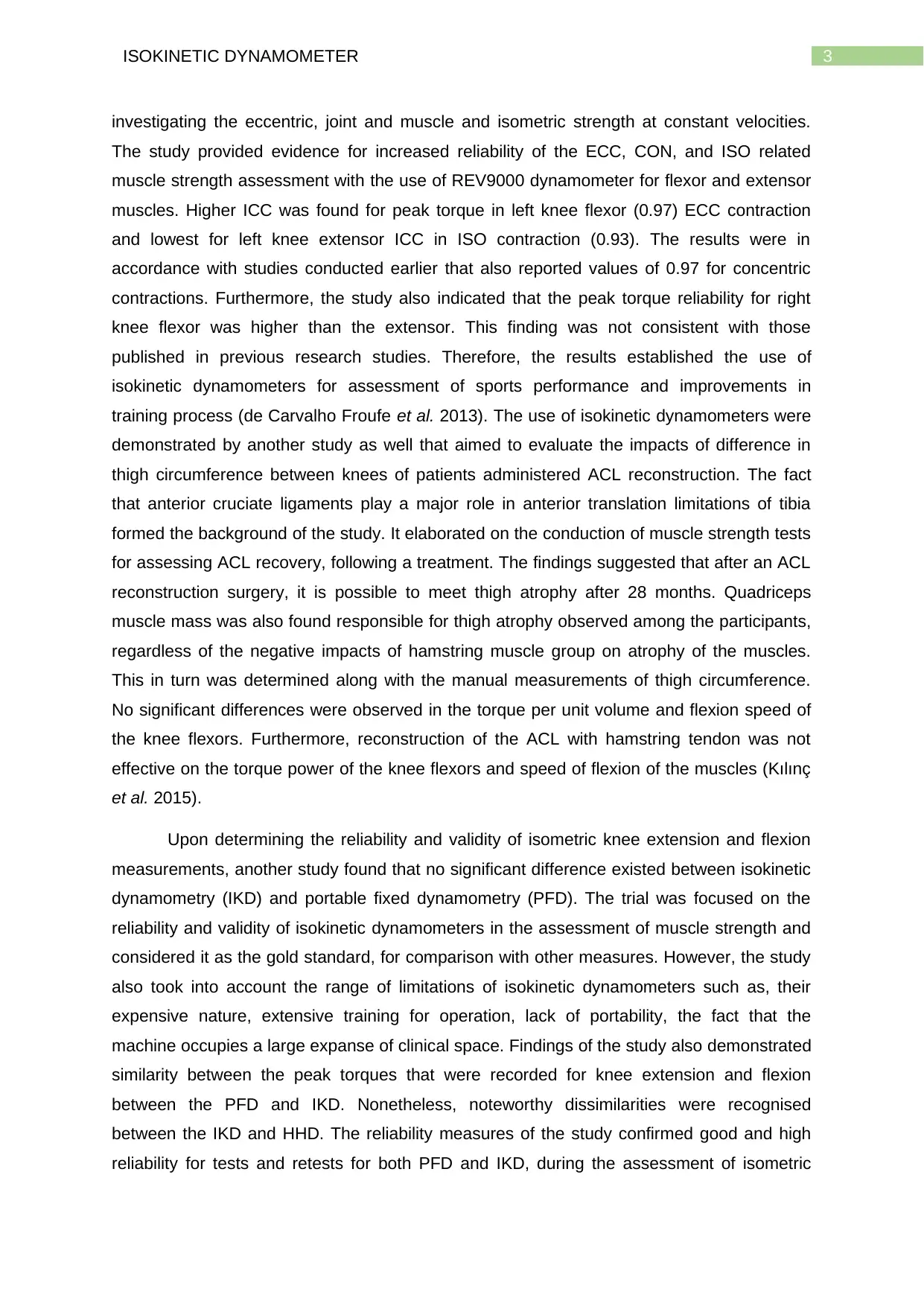
3ISOKINETIC DYNAMOMETER
investigating the eccentric, joint and muscle and isometric strength at constant velocities.
The study provided evidence for increased reliability of the ECC, CON, and ISO related
muscle strength assessment with the use of REV9000 dynamometer for flexor and extensor
muscles. Higher ICC was found for peak torque in left knee flexor (0.97) ECC contraction
and lowest for left knee extensor ICC in ISO contraction (0.93). The results were in
accordance with studies conducted earlier that also reported values of 0.97 for concentric
contractions. Furthermore, the study also indicated that the peak torque reliability for right
knee flexor was higher than the extensor. This finding was not consistent with those
published in previous research studies. Therefore, the results established the use of
isokinetic dynamometers for assessment of sports performance and improvements in
training process (de Carvalho Froufe et al. 2013). The use of isokinetic dynamometers were
demonstrated by another study as well that aimed to evaluate the impacts of difference in
thigh circumference between knees of patients administered ACL reconstruction. The fact
that anterior cruciate ligaments play a major role in anterior translation limitations of tibia
formed the background of the study. It elaborated on the conduction of muscle strength tests
for assessing ACL recovery, following a treatment. The findings suggested that after an ACL
reconstruction surgery, it is possible to meet thigh atrophy after 28 months. Quadriceps
muscle mass was also found responsible for thigh atrophy observed among the participants,
regardless of the negative impacts of hamstring muscle group on atrophy of the muscles.
This in turn was determined along with the manual measurements of thigh circumference.
No significant differences were observed in the torque per unit volume and flexion speed of
the knee flexors. Furthermore, reconstruction of the ACL with hamstring tendon was not
effective on the torque power of the knee flexors and speed of flexion of the muscles (Kılınç
et al. 2015).
Upon determining the reliability and validity of isometric knee extension and flexion
measurements, another study found that no significant difference existed between isokinetic
dynamometry (IKD) and portable fixed dynamometry (PFD). The trial was focused on the
reliability and validity of isokinetic dynamometers in the assessment of muscle strength and
considered it as the gold standard, for comparison with other measures. However, the study
also took into account the range of limitations of isokinetic dynamometers such as, their
expensive nature, extensive training for operation, lack of portability, the fact that the
machine occupies a large expanse of clinical space. Findings of the study also demonstrated
similarity between the peak torques that were recorded for knee extension and flexion
between the PFD and IKD. Nonetheless, noteworthy dissimilarities were recognised
between the IKD and HHD. The reliability measures of the study confirmed good and high
reliability for tests and retests for both PFD and IKD, during the assessment of isometric
investigating the eccentric, joint and muscle and isometric strength at constant velocities.
The study provided evidence for increased reliability of the ECC, CON, and ISO related
muscle strength assessment with the use of REV9000 dynamometer for flexor and extensor
muscles. Higher ICC was found for peak torque in left knee flexor (0.97) ECC contraction
and lowest for left knee extensor ICC in ISO contraction (0.93). The results were in
accordance with studies conducted earlier that also reported values of 0.97 for concentric
contractions. Furthermore, the study also indicated that the peak torque reliability for right
knee flexor was higher than the extensor. This finding was not consistent with those
published in previous research studies. Therefore, the results established the use of
isokinetic dynamometers for assessment of sports performance and improvements in
training process (de Carvalho Froufe et al. 2013). The use of isokinetic dynamometers were
demonstrated by another study as well that aimed to evaluate the impacts of difference in
thigh circumference between knees of patients administered ACL reconstruction. The fact
that anterior cruciate ligaments play a major role in anterior translation limitations of tibia
formed the background of the study. It elaborated on the conduction of muscle strength tests
for assessing ACL recovery, following a treatment. The findings suggested that after an ACL
reconstruction surgery, it is possible to meet thigh atrophy after 28 months. Quadriceps
muscle mass was also found responsible for thigh atrophy observed among the participants,
regardless of the negative impacts of hamstring muscle group on atrophy of the muscles.
This in turn was determined along with the manual measurements of thigh circumference.
No significant differences were observed in the torque per unit volume and flexion speed of
the knee flexors. Furthermore, reconstruction of the ACL with hamstring tendon was not
effective on the torque power of the knee flexors and speed of flexion of the muscles (Kılınç
et al. 2015).
Upon determining the reliability and validity of isometric knee extension and flexion
measurements, another study found that no significant difference existed between isokinetic
dynamometry (IKD) and portable fixed dynamometry (PFD). The trial was focused on the
reliability and validity of isokinetic dynamometers in the assessment of muscle strength and
considered it as the gold standard, for comparison with other measures. However, the study
also took into account the range of limitations of isokinetic dynamometers such as, their
expensive nature, extensive training for operation, lack of portability, the fact that the
machine occupies a large expanse of clinical space. Findings of the study also demonstrated
similarity between the peak torques that were recorded for knee extension and flexion
between the PFD and IKD. Nonetheless, noteworthy dissimilarities were recognised
between the IKD and HHD. The reliability measures of the study confirmed good and high
reliability for tests and retests for both PFD and IKD, during the assessment of isometric
Paraphrase This Document
Need a fresh take? Get an instant paraphrase of this document with our AI Paraphraser
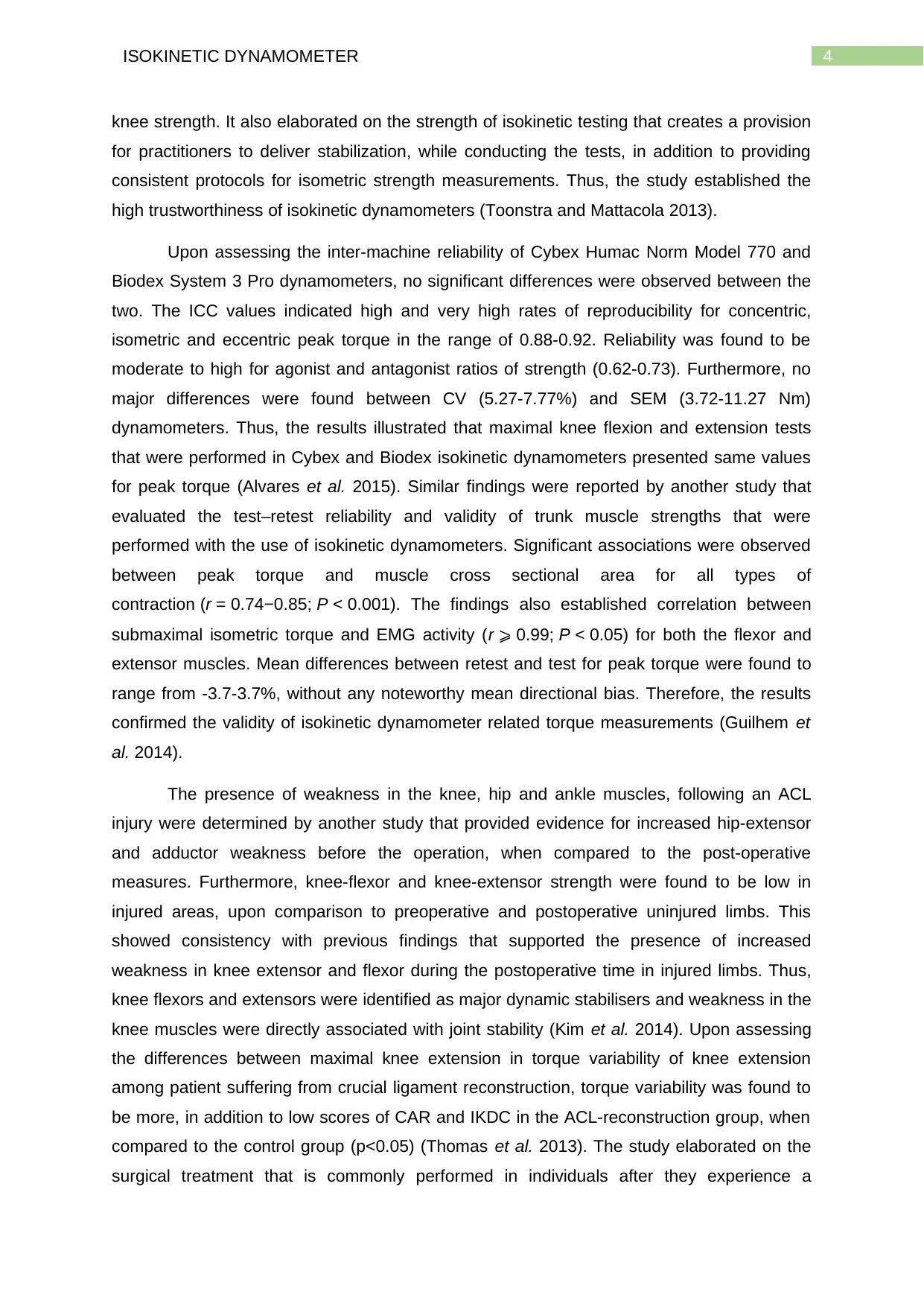
4ISOKINETIC DYNAMOMETER
knee strength. It also elaborated on the strength of isokinetic testing that creates a provision
for practitioners to deliver stabilization, while conducting the tests, in addition to providing
consistent protocols for isometric strength measurements. Thus, the study established the
high trustworthiness of isokinetic dynamometers (Toonstra and Mattacola 2013).
Upon assessing the inter-machine reliability of Cybex Humac Norm Model 770 and
Biodex System 3 Pro dynamometers, no significant differences were observed between the
two. The ICC values indicated high and very high rates of reproducibility for concentric,
isometric and eccentric peak torque in the range of 0.88-0.92. Reliability was found to be
moderate to high for agonist and antagonist ratios of strength (0.62-0.73). Furthermore, no
major differences were found between CV (5.27-7.77%) and SEM (3.72-11.27 Nm)
dynamometers. Thus, the results illustrated that maximal knee flexion and extension tests
that were performed in Cybex and Biodex isokinetic dynamometers presented same values
for peak torque (Alvares et al. 2015). Similar findings were reported by another study that
evaluated the test–retest reliability and validity of trunk muscle strengths that were
performed with the use of isokinetic dynamometers. Significant associations were observed
between peak torque and muscle cross sectional area for all types of
contraction (r = 0.74−0.85; P < 0.001). The findings also established correlation between
submaximal isometric torque and EMG activity (r ⩾ 0.99; P < 0.05) for both the flexor and
extensor muscles. Mean differences between retest and test for peak torque were found to
range from -3.7-3.7%, without any noteworthy mean directional bias. Therefore, the results
confirmed the validity of isokinetic dynamometer related torque measurements (Guilhem et
al. 2014).
The presence of weakness in the knee, hip and ankle muscles, following an ACL
injury were determined by another study that provided evidence for increased hip-extensor
and adductor weakness before the operation, when compared to the post-operative
measures. Furthermore, knee-flexor and knee-extensor strength were found to be low in
injured areas, upon comparison to preoperative and postoperative uninjured limbs. This
showed consistency with previous findings that supported the presence of increased
weakness in knee extensor and flexor during the postoperative time in injured limbs. Thus,
knee flexors and extensors were identified as major dynamic stabilisers and weakness in the
knee muscles were directly associated with joint stability (Kim et al. 2014). Upon assessing
the differences between maximal knee extension in torque variability of knee extension
among patient suffering from crucial ligament reconstruction, torque variability was found to
be more, in addition to low scores of CAR and IKDC in the ACL-reconstruction group, when
compared to the control group (p<0.05) (Thomas et al. 2013). The study elaborated on the
surgical treatment that is commonly performed in individuals after they experience a
knee strength. It also elaborated on the strength of isokinetic testing that creates a provision
for practitioners to deliver stabilization, while conducting the tests, in addition to providing
consistent protocols for isometric strength measurements. Thus, the study established the
high trustworthiness of isokinetic dynamometers (Toonstra and Mattacola 2013).
Upon assessing the inter-machine reliability of Cybex Humac Norm Model 770 and
Biodex System 3 Pro dynamometers, no significant differences were observed between the
two. The ICC values indicated high and very high rates of reproducibility for concentric,
isometric and eccentric peak torque in the range of 0.88-0.92. Reliability was found to be
moderate to high for agonist and antagonist ratios of strength (0.62-0.73). Furthermore, no
major differences were found between CV (5.27-7.77%) and SEM (3.72-11.27 Nm)
dynamometers. Thus, the results illustrated that maximal knee flexion and extension tests
that were performed in Cybex and Biodex isokinetic dynamometers presented same values
for peak torque (Alvares et al. 2015). Similar findings were reported by another study that
evaluated the test–retest reliability and validity of trunk muscle strengths that were
performed with the use of isokinetic dynamometers. Significant associations were observed
between peak torque and muscle cross sectional area for all types of
contraction (r = 0.74−0.85; P < 0.001). The findings also established correlation between
submaximal isometric torque and EMG activity (r ⩾ 0.99; P < 0.05) for both the flexor and
extensor muscles. Mean differences between retest and test for peak torque were found to
range from -3.7-3.7%, without any noteworthy mean directional bias. Therefore, the results
confirmed the validity of isokinetic dynamometer related torque measurements (Guilhem et
al. 2014).
The presence of weakness in the knee, hip and ankle muscles, following an ACL
injury were determined by another study that provided evidence for increased hip-extensor
and adductor weakness before the operation, when compared to the post-operative
measures. Furthermore, knee-flexor and knee-extensor strength were found to be low in
injured areas, upon comparison to preoperative and postoperative uninjured limbs. This
showed consistency with previous findings that supported the presence of increased
weakness in knee extensor and flexor during the postoperative time in injured limbs. Thus,
knee flexors and extensors were identified as major dynamic stabilisers and weakness in the
knee muscles were directly associated with joint stability (Kim et al. 2014). Upon assessing
the differences between maximal knee extension in torque variability of knee extension
among patient suffering from crucial ligament reconstruction, torque variability was found to
be more, in addition to low scores of CAR and IKDC in the ACL-reconstruction group, when
compared to the control group (p<0.05) (Thomas et al. 2013). The study elaborated on the
surgical treatment that is commonly performed in individuals after they experience a
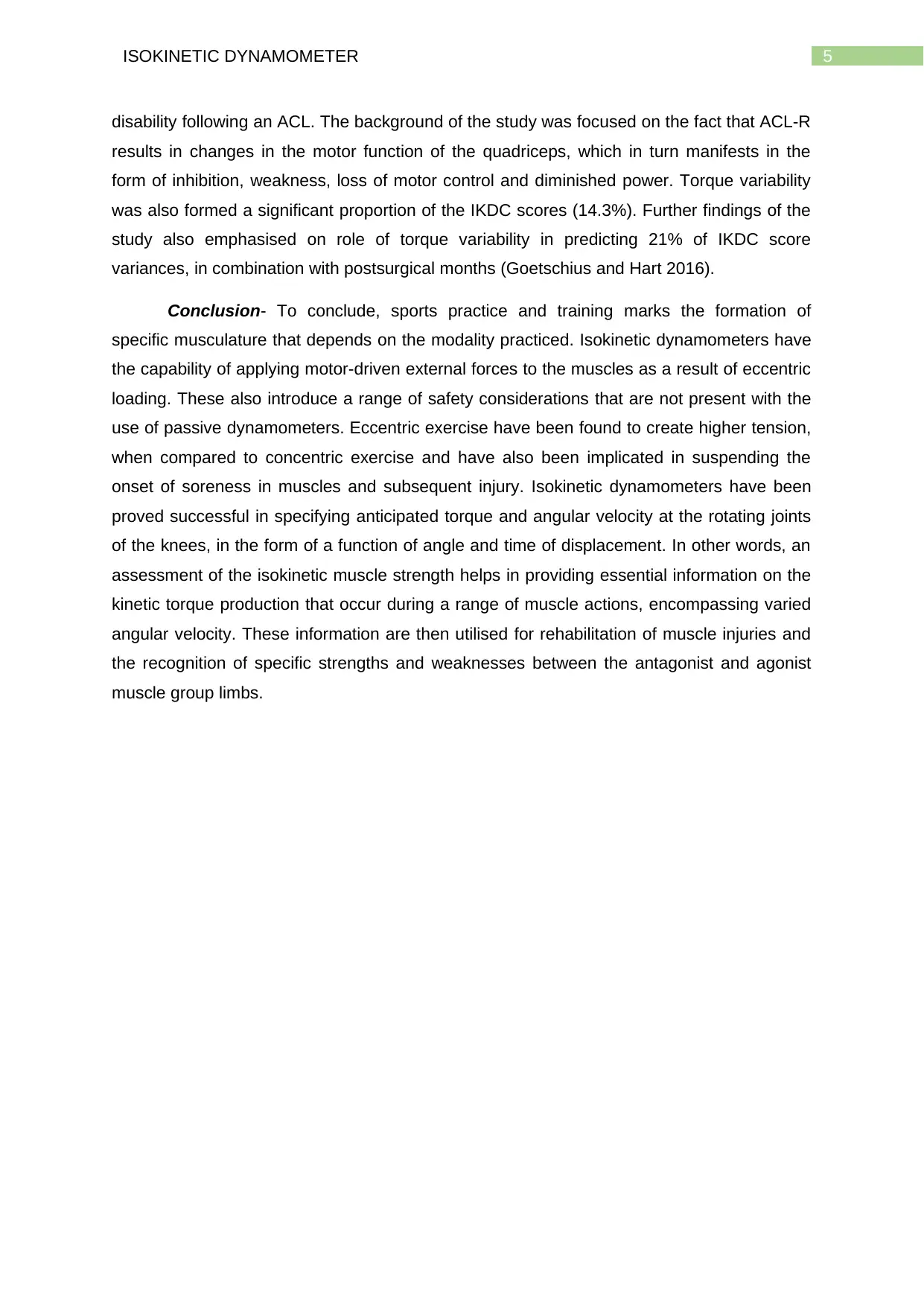
5ISOKINETIC DYNAMOMETER
disability following an ACL. The background of the study was focused on the fact that ACL-R
results in changes in the motor function of the quadriceps, which in turn manifests in the
form of inhibition, weakness, loss of motor control and diminished power. Torque variability
was also formed a significant proportion of the IKDC scores (14.3%). Further findings of the
study also emphasised on role of torque variability in predicting 21% of IKDC score
variances, in combination with postsurgical months (Goetschius and Hart 2016).
Conclusion- To conclude, sports practice and training marks the formation of
specific musculature that depends on the modality practiced. Isokinetic dynamometers have
the capability of applying motor-driven external forces to the muscles as a result of eccentric
loading. These also introduce a range of safety considerations that are not present with the
use of passive dynamometers. Eccentric exercise have been found to create higher tension,
when compared to concentric exercise and have also been implicated in suspending the
onset of soreness in muscles and subsequent injury. Isokinetic dynamometers have been
proved successful in specifying anticipated torque and angular velocity at the rotating joints
of the knees, in the form of a function of angle and time of displacement. In other words, an
assessment of the isokinetic muscle strength helps in providing essential information on the
kinetic torque production that occur during a range of muscle actions, encompassing varied
angular velocity. These information are then utilised for rehabilitation of muscle injuries and
the recognition of specific strengths and weaknesses between the antagonist and agonist
muscle group limbs.
disability following an ACL. The background of the study was focused on the fact that ACL-R
results in changes in the motor function of the quadriceps, which in turn manifests in the
form of inhibition, weakness, loss of motor control and diminished power. Torque variability
was also formed a significant proportion of the IKDC scores (14.3%). Further findings of the
study also emphasised on role of torque variability in predicting 21% of IKDC score
variances, in combination with postsurgical months (Goetschius and Hart 2016).
Conclusion- To conclude, sports practice and training marks the formation of
specific musculature that depends on the modality practiced. Isokinetic dynamometers have
the capability of applying motor-driven external forces to the muscles as a result of eccentric
loading. These also introduce a range of safety considerations that are not present with the
use of passive dynamometers. Eccentric exercise have been found to create higher tension,
when compared to concentric exercise and have also been implicated in suspending the
onset of soreness in muscles and subsequent injury. Isokinetic dynamometers have been
proved successful in specifying anticipated torque and angular velocity at the rotating joints
of the knees, in the form of a function of angle and time of displacement. In other words, an
assessment of the isokinetic muscle strength helps in providing essential information on the
kinetic torque production that occur during a range of muscle actions, encompassing varied
angular velocity. These information are then utilised for rehabilitation of muscle injuries and
the recognition of specific strengths and weaknesses between the antagonist and agonist
muscle group limbs.
⊘ This is a preview!⊘
Do you want full access?
Subscribe today to unlock all pages.

Trusted by 1+ million students worldwide
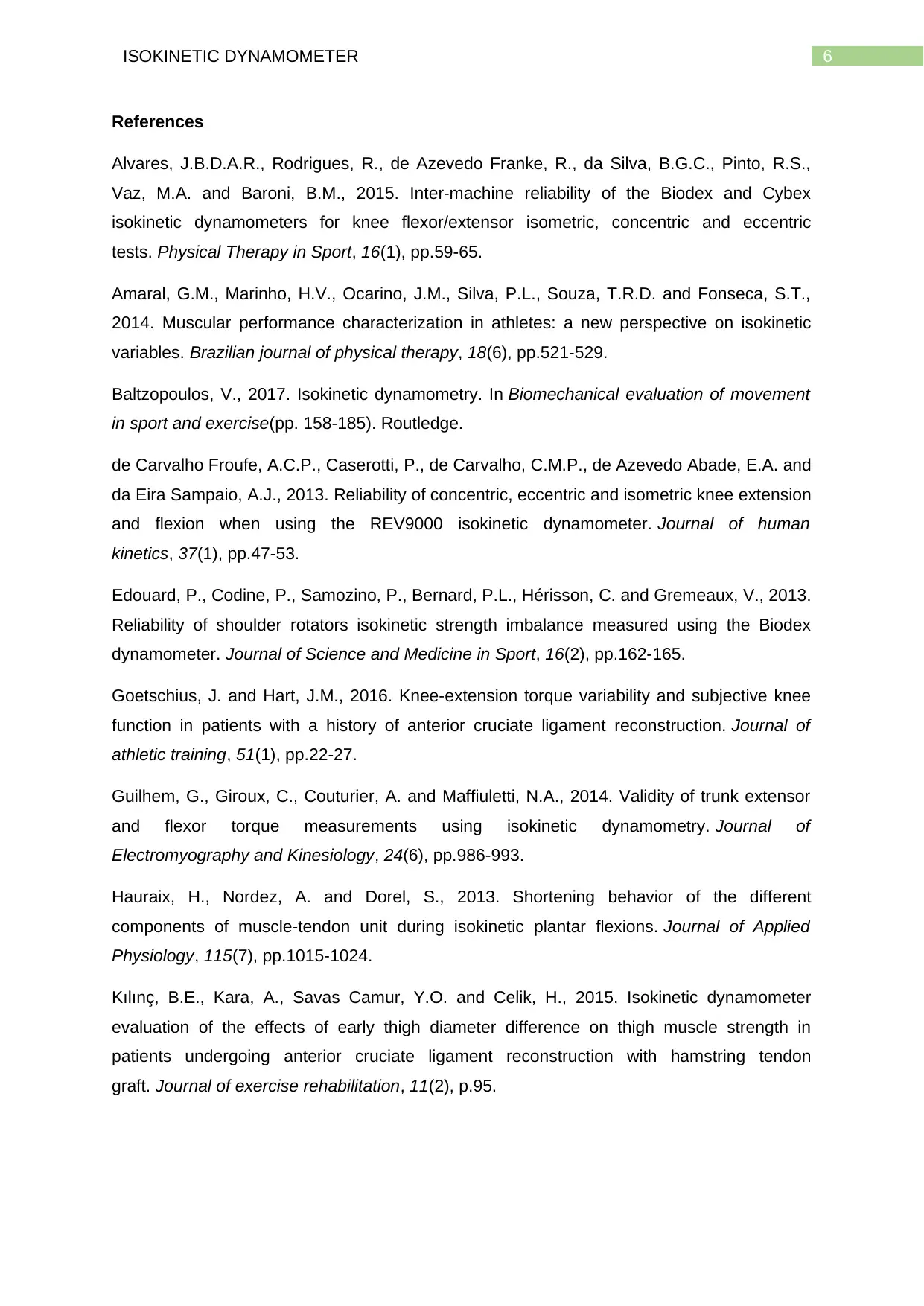
6ISOKINETIC DYNAMOMETER
References
Alvares, J.B.D.A.R., Rodrigues, R., de Azevedo Franke, R., da Silva, B.G.C., Pinto, R.S.,
Vaz, M.A. and Baroni, B.M., 2015. Inter-machine reliability of the Biodex and Cybex
isokinetic dynamometers for knee flexor/extensor isometric, concentric and eccentric
tests. Physical Therapy in Sport, 16(1), pp.59-65.
Amaral, G.M., Marinho, H.V., Ocarino, J.M., Silva, P.L., Souza, T.R.D. and Fonseca, S.T.,
2014. Muscular performance characterization in athletes: a new perspective on isokinetic
variables. Brazilian journal of physical therapy, 18(6), pp.521-529.
Baltzopoulos, V., 2017. Isokinetic dynamometry. In Biomechanical evaluation of movement
in sport and exercise(pp. 158-185). Routledge.
de Carvalho Froufe, A.C.P., Caserotti, P., de Carvalho, C.M.P., de Azevedo Abade, E.A. and
da Eira Sampaio, A.J., 2013. Reliability of concentric, eccentric and isometric knee extension
and flexion when using the REV9000 isokinetic dynamometer. Journal of human
kinetics, 37(1), pp.47-53.
Edouard, P., Codine, P., Samozino, P., Bernard, P.L., Hérisson, C. and Gremeaux, V., 2013.
Reliability of shoulder rotators isokinetic strength imbalance measured using the Biodex
dynamometer. Journal of Science and Medicine in Sport, 16(2), pp.162-165.
Goetschius, J. and Hart, J.M., 2016. Knee-extension torque variability and subjective knee
function in patients with a history of anterior cruciate ligament reconstruction. Journal of
athletic training, 51(1), pp.22-27.
Guilhem, G., Giroux, C., Couturier, A. and Maffiuletti, N.A., 2014. Validity of trunk extensor
and flexor torque measurements using isokinetic dynamometry. Journal of
Electromyography and Kinesiology, 24(6), pp.986-993.
Hauraix, H., Nordez, A. and Dorel, S., 2013. Shortening behavior of the different
components of muscle-tendon unit during isokinetic plantar flexions. Journal of Applied
Physiology, 115(7), pp.1015-1024.
Kılınç, B.E., Kara, A., Savas Camur, Y.O. and Celik, H., 2015. Isokinetic dynamometer
evaluation of the effects of early thigh diameter difference on thigh muscle strength in
patients undergoing anterior cruciate ligament reconstruction with hamstring tendon
graft. Journal of exercise rehabilitation, 11(2), p.95.
References
Alvares, J.B.D.A.R., Rodrigues, R., de Azevedo Franke, R., da Silva, B.G.C., Pinto, R.S.,
Vaz, M.A. and Baroni, B.M., 2015. Inter-machine reliability of the Biodex and Cybex
isokinetic dynamometers for knee flexor/extensor isometric, concentric and eccentric
tests. Physical Therapy in Sport, 16(1), pp.59-65.
Amaral, G.M., Marinho, H.V., Ocarino, J.M., Silva, P.L., Souza, T.R.D. and Fonseca, S.T.,
2014. Muscular performance characterization in athletes: a new perspective on isokinetic
variables. Brazilian journal of physical therapy, 18(6), pp.521-529.
Baltzopoulos, V., 2017. Isokinetic dynamometry. In Biomechanical evaluation of movement
in sport and exercise(pp. 158-185). Routledge.
de Carvalho Froufe, A.C.P., Caserotti, P., de Carvalho, C.M.P., de Azevedo Abade, E.A. and
da Eira Sampaio, A.J., 2013. Reliability of concentric, eccentric and isometric knee extension
and flexion when using the REV9000 isokinetic dynamometer. Journal of human
kinetics, 37(1), pp.47-53.
Edouard, P., Codine, P., Samozino, P., Bernard, P.L., Hérisson, C. and Gremeaux, V., 2013.
Reliability of shoulder rotators isokinetic strength imbalance measured using the Biodex
dynamometer. Journal of Science and Medicine in Sport, 16(2), pp.162-165.
Goetschius, J. and Hart, J.M., 2016. Knee-extension torque variability and subjective knee
function in patients with a history of anterior cruciate ligament reconstruction. Journal of
athletic training, 51(1), pp.22-27.
Guilhem, G., Giroux, C., Couturier, A. and Maffiuletti, N.A., 2014. Validity of trunk extensor
and flexor torque measurements using isokinetic dynamometry. Journal of
Electromyography and Kinesiology, 24(6), pp.986-993.
Hauraix, H., Nordez, A. and Dorel, S., 2013. Shortening behavior of the different
components of muscle-tendon unit during isokinetic plantar flexions. Journal of Applied
Physiology, 115(7), pp.1015-1024.
Kılınç, B.E., Kara, A., Savas Camur, Y.O. and Celik, H., 2015. Isokinetic dynamometer
evaluation of the effects of early thigh diameter difference on thigh muscle strength in
patients undergoing anterior cruciate ligament reconstruction with hamstring tendon
graft. Journal of exercise rehabilitation, 11(2), p.95.
Paraphrase This Document
Need a fresh take? Get an instant paraphrase of this document with our AI Paraphraser
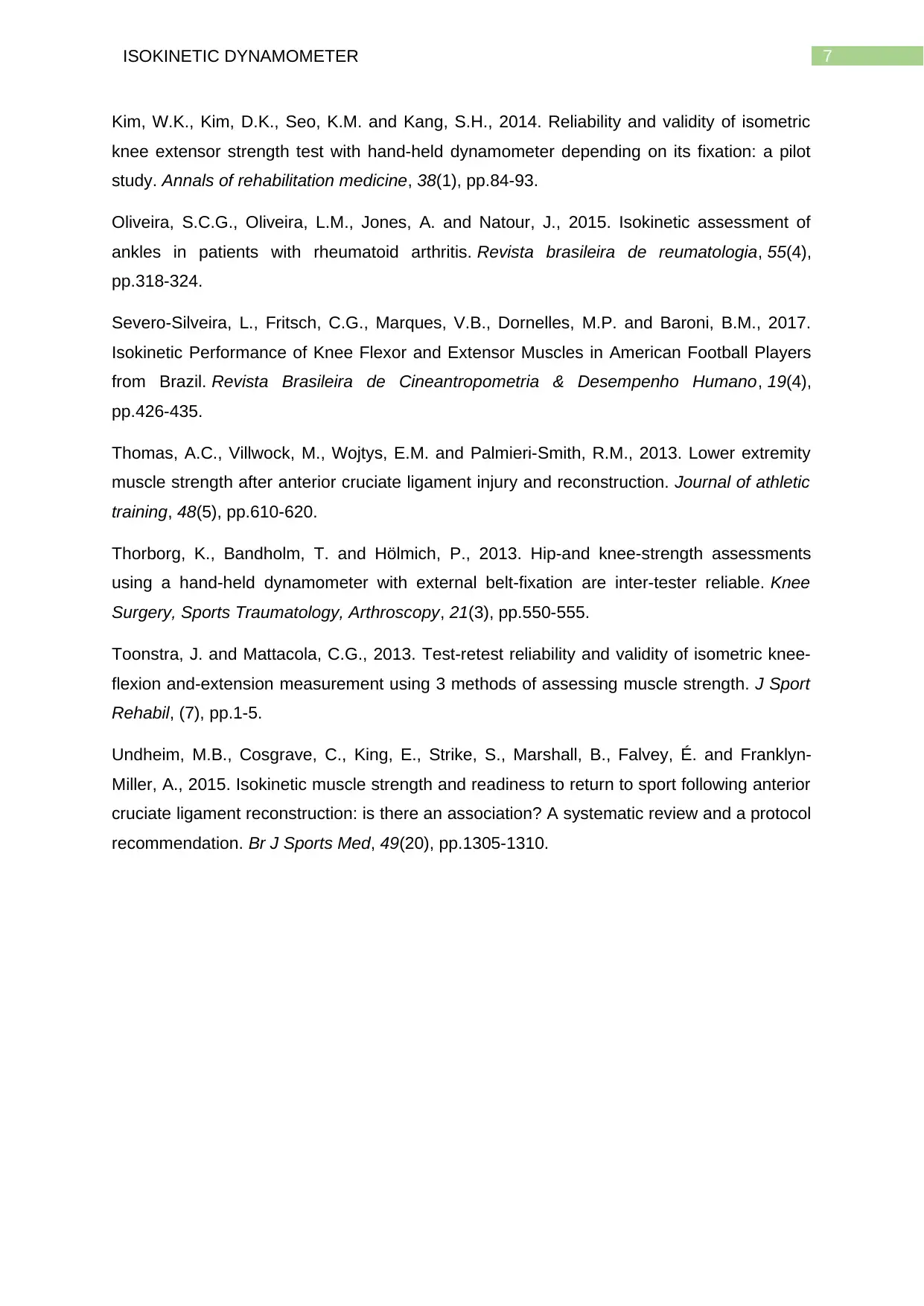
7ISOKINETIC DYNAMOMETER
Kim, W.K., Kim, D.K., Seo, K.M. and Kang, S.H., 2014. Reliability and validity of isometric
knee extensor strength test with hand-held dynamometer depending on its fixation: a pilot
study. Annals of rehabilitation medicine, 38(1), pp.84-93.
Oliveira, S.C.G., Oliveira, L.M., Jones, A. and Natour, J., 2015. Isokinetic assessment of
ankles in patients with rheumatoid arthritis. Revista brasileira de reumatologia, 55(4),
pp.318-324.
Severo-Silveira, L., Fritsch, C.G., Marques, V.B., Dornelles, M.P. and Baroni, B.M., 2017.
Isokinetic Performance of Knee Flexor and Extensor Muscles in American Football Players
from Brazil. Revista Brasileira de Cineantropometria & Desempenho Humano, 19(4),
pp.426-435.
Thomas, A.C., Villwock, M., Wojtys, E.M. and Palmieri-Smith, R.M., 2013. Lower extremity
muscle strength after anterior cruciate ligament injury and reconstruction. Journal of athletic
training, 48(5), pp.610-620.
Thorborg, K., Bandholm, T. and Hölmich, P., 2013. Hip-and knee-strength assessments
using a hand-held dynamometer with external belt-fixation are inter-tester reliable. Knee
Surgery, Sports Traumatology, Arthroscopy, 21(3), pp.550-555.
Toonstra, J. and Mattacola, C.G., 2013. Test-retest reliability and validity of isometric knee-
flexion and-extension measurement using 3 methods of assessing muscle strength. J Sport
Rehabil, (7), pp.1-5.
Undheim, M.B., Cosgrave, C., King, E., Strike, S., Marshall, B., Falvey, É. and Franklyn-
Miller, A., 2015. Isokinetic muscle strength and readiness to return to sport following anterior
cruciate ligament reconstruction: is there an association? A systematic review and a protocol
recommendation. Br J Sports Med, 49(20), pp.1305-1310.
Kim, W.K., Kim, D.K., Seo, K.M. and Kang, S.H., 2014. Reliability and validity of isometric
knee extensor strength test with hand-held dynamometer depending on its fixation: a pilot
study. Annals of rehabilitation medicine, 38(1), pp.84-93.
Oliveira, S.C.G., Oliveira, L.M., Jones, A. and Natour, J., 2015. Isokinetic assessment of
ankles in patients with rheumatoid arthritis. Revista brasileira de reumatologia, 55(4),
pp.318-324.
Severo-Silveira, L., Fritsch, C.G., Marques, V.B., Dornelles, M.P. and Baroni, B.M., 2017.
Isokinetic Performance of Knee Flexor and Extensor Muscles in American Football Players
from Brazil. Revista Brasileira de Cineantropometria & Desempenho Humano, 19(4),
pp.426-435.
Thomas, A.C., Villwock, M., Wojtys, E.M. and Palmieri-Smith, R.M., 2013. Lower extremity
muscle strength after anterior cruciate ligament injury and reconstruction. Journal of athletic
training, 48(5), pp.610-620.
Thorborg, K., Bandholm, T. and Hölmich, P., 2013. Hip-and knee-strength assessments
using a hand-held dynamometer with external belt-fixation are inter-tester reliable. Knee
Surgery, Sports Traumatology, Arthroscopy, 21(3), pp.550-555.
Toonstra, J. and Mattacola, C.G., 2013. Test-retest reliability and validity of isometric knee-
flexion and-extension measurement using 3 methods of assessing muscle strength. J Sport
Rehabil, (7), pp.1-5.
Undheim, M.B., Cosgrave, C., King, E., Strike, S., Marshall, B., Falvey, É. and Franklyn-
Miller, A., 2015. Isokinetic muscle strength and readiness to return to sport following anterior
cruciate ligament reconstruction: is there an association? A systematic review and a protocol
recommendation. Br J Sports Med, 49(20), pp.1305-1310.
1 out of 8
Your All-in-One AI-Powered Toolkit for Academic Success.
+13062052269
info@desklib.com
Available 24*7 on WhatsApp / Email
![[object Object]](/_next/static/media/star-bottom.7253800d.svg)
Unlock your academic potential
Copyright © 2020–2025 A2Z Services. All Rights Reserved. Developed and managed by ZUCOL.

